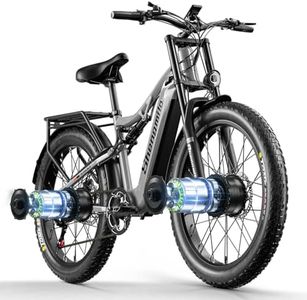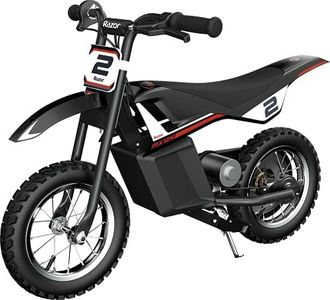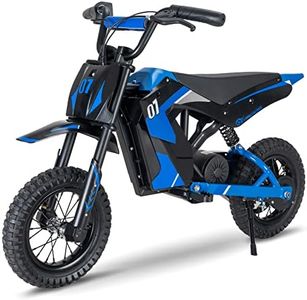We Use CookiesWe use cookies to enhance the security, performance,
functionality and for analytical and promotional activities. By continuing to browse this site you
are agreeing to our privacy policy
5 Best Electric Dirt Bikes
From leading brands and best sellers available on the web.Buying Guide for the Best Electric Dirt Bikes
Choosing the right electric dirt bike involves understanding your own riding needs and matching them to the bike's core features. You need to consider where you’ll ride, your experience level, how much power you want, and how long you expect to be out riding between charges. Focus on what kind of terrain you'll tackle (like trails, tracks, or open land), whether you’re riding for fun or sport, and your physical build so the bike suits you comfortably. When you know your priorities, you can easily narrow down the best fit.Motor PowerMotor power, usually listed in watts (W) or kilowatts (kW), tells you how strong and fast the bike can go. Higher power means more acceleration and the ability to handle steeper hills or rougher ground. For young beginners or light trail riding, a lower power (around 500W to 1500W) is suitable. Intermediate riders or those on tougher trails often look for 2000W to 4000W. Advanced enthusiasts who want to race or tackle very rugged environments may choose bikes with even higher power. Think about your experience and the surfaces you’ll ride on, and pick a power level that you can both handle and enjoy.
Battery Capacity and RangeBattery capacity, measured in amp-hours (Ah) or watt-hours (Wh), determines how far you can travel on a single charge. A larger battery means a longer range, but can also mean a heavier bike. Short commutes or light trail sessions might do fine with a smaller battery, offering 1-2 hours of ride time. If you plan long adventures in remote areas, go for a larger battery to avoid running out of power too soon. Always estimate your typical ride length and pick a battery capacity that covers it with some extra for peace of mind.
Bike WeightThe weight of an electric dirt bike affects how easy it is to control and transport. Lighter bikes (under 50 kg/110 lbs) are ideal for kids and beginners because they are easier to maneuver. Medium weight models (50–75 kg or 110–165 lbs) suit most teens and adults for recreational use. Heavier bikes are built for rough racing or skilled adults; these offer more stability at high speeds but can be tricky to handle, especially for less experienced riders. Consider your strength, skill, and how you’ll move or lift the bike when choosing the right weight.
Suspension Type and TravelSuspension absorbs shocks from bumps and jumps, affecting comfort and control. Suspension 'travel' is the distance it moves to absorb impacts, usually measured in millimeters. Light trail and casual use can manage with less travel (70–120 mm). For off-road racing or frequent jumps, you’ll want long-travel suspension (150 mm or more) for maximum cushioning. Areas with lots of rocks, roots, or uneven ground especially benefit from better suspension. Match the suspension type and travel to the roughest terrain you'll regularly encounter.
Seat HeightSeat height is how high the seat is from the ground, and choosing the correct one is critical for feeling balanced and in control. Lower seat heights (under 30 inches) suit shorter riders or kids, making it easier to place feet flat on the ground. Taller seat heights (32 inches or higher) work better for adults or those with longer legs, offering more room for movement, especially during aggressive riding. Sit on the bike if possible and make sure both feet can touch the ground before picking to ensure safety and riding comfort.
Tire Size and TypeTire size is usually listed in inches and affects how the bike grips different terrains. Smaller wheels (16–18 inches) make the bike more agile and are suited for young riders or tight tracks. Larger wheels (19–21 inches) help adults maintain stability over rough or soft ground. Tires for off-road usually have knobby, deep treads for grip, while smoother tires are better for lighter trails or mixed use. Consider the land you’ll ride on most, and pick a tire size and style that matches it.
BrakesBrakes are either disc or drum, but most good electric dirt bikes use disc brakes for better stopping power and control, especially in mud or wet conditions. The size of the brake disc and whether it's hydraulic or mechanical affects how much stopping force you get. Beginners and casual riders can use smaller, mechanical discs, but frequent off-roaders or racers should look for larger, hydraulic ones for stronger, more reliable braking. Safety is key, so always pick brakes suited to your riding intensity and terrain.





